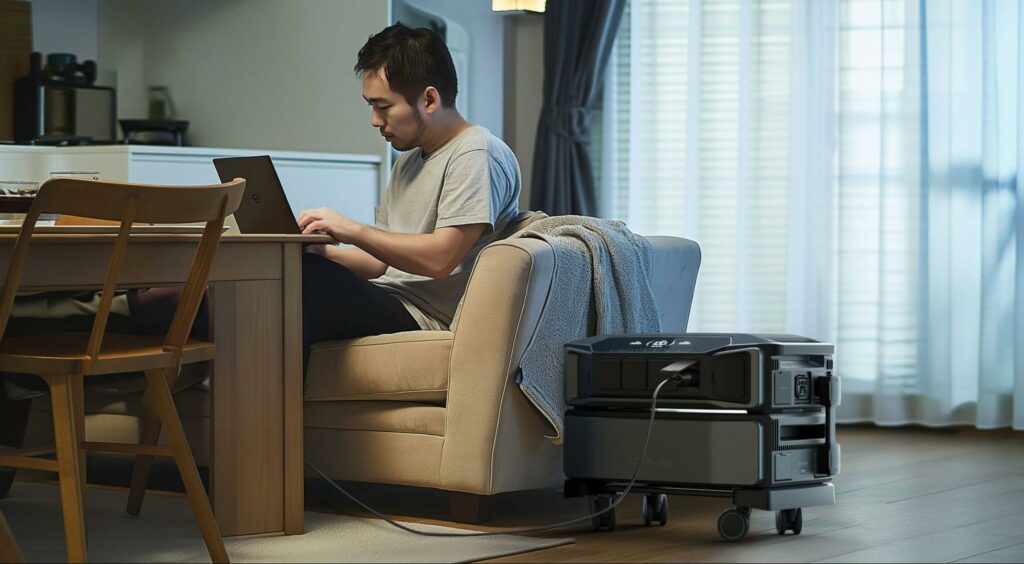Table of Contents
Access to clean, uninterrupted power has become a necessity for many people.
At the same time, extreme weather events, natural disasters, and aging electric grid infrastructure have made blackouts and brownouts much more frequent.
If you work from home or rely on sensitive electronics like hard drives, servers, and desktop computers, you may have heard of a UPS.
But what exactly does a UPS do?
And how does it work?
Read on to find out.
What Does a UPS Power Supply Do?
UPS stands for Uninterruptible Power Supply, and it protects sensitive electronics like desktop computers, hard drives, and servers from power outages and variations in voltage, current, and resistance (brownouts).
Gaming and home entertainment systems may also contain delicate semiconductors and other electronic components that can be permanently damaged in a blackout.
Conditioning the grid power your devices receive with a UPS can increase their lifespan and performance.
Even if full-blown blackouts are rare in your location, you likely experience brownouts — even if you don’t know it.
If you’ve ever seen the lights briefly dim in your home without going out — that’s a brownout.
Variations in the quality of electricity you receive from the grid are often imperceptible to the human eye but take a serious toll on your devices.
Grid power is relatively “clean” compared to, say, a portable gas generator, which produces electricity with a high level of Total Harmonic Distortion (THD).
Electricity with a measurable level of THD is frequently called “dirty power.”
Most UPS models also include a battery to give you time to shut down your systems correctly during a blackout.
Smaller UPS units may only give you a few minutes to shut down before the battery runs out.
Portable power stations like Ecoflow’s DELTA 2 Max provide an uninterruptible electricity supply and home battery backup.
Instead of feeling under the gun to shut down your systems, you can run them for hours during an outage.
Even better, EcoFlow’s DELTA series can recharge using solar panels as well as household (AC) power, potentially giving you a UPS that can keep your essential appliances up and running indefinitely during a blackout.

What Are the Different Types of Uninterruptible Power Supplies?
There are three basic types of UPS, as well as backup battery solutions, that offer uninterrupted power during a blackout.
Here’s a summary of each.
Double Conversion or Online UPS
Online UPS units are the gold standard for applications that require clean power and instantaneous auto-switchover in a blackout.
Double conversion UPS is frequently used in server farms and data storage applications.
A double conversion online UPS converts electricity twice: from AC (grid power) to DC and back to AC for output.
Online UPS units typically contain the following components:
- Rectifier
- Inverter
- Bypass switch
- Battery*
- Battery to DC converter*
*Optional
Passing grid AC electricity through the rectifier and inverter eliminates spikes in voltage and other THD effects, resulting in cleaner output power.
Battery storage is optional in double-conversion UPS models, as some applications only require the power conditioning provided by the rectifier and inversion process.
However, most online UPS models feature battery storage and uninterrupted power during a blackout.
How long a UPS can run your devices during a power outage is determined by:
- Battery storage capacity (in amp-hours or watt-hours/kilowatt-hours)
- Electrical load (how much electricity in watts do the connected devices consume)
Standby or Off-Line UPS
Off-line or standby UPS units don’t offer the same level of protection against voltage spikes, brownouts, and THD as online UPS models.
However, standby UPS is often the cheaper option, and it may be suitable for applications where “clean” power is not a high priority.
Standby UPS units include a battery and inverter but not a rectifier.
They skip the double conversion process, resulting in slightly “dirtier” power.
The switchover time during an outage is fast but not instantaneous: typically, it is 6-10 milliseconds (ms).
Standby UPS models are typically suitable for smaller devices and systems (under 1500VA).
The primary purpose of a UPS is to allow you to shut down your computer and other devices following the proper procedure rather than risk damage through a sudden interruption of power.
Off-line UPS offers basic surge protection but is still susceptible to THD and brownouts.
If you need power conditioning in addition to backup from a UPS, an online inverter is the better choice.
Line-Interactive UPS
Line-interactive UPS models offer more power conditioning benefits than offline UPS in addition to backup power.
The auto-switchover time to battery backup is shorter (4-6 ms) and handles variations in voltage and THD more efficiently, resulting in cleaner power.
However, it’s still less suitable for clean power applications than an online UPS or double-conversion model.
Line-interactive units offer a middle ground between offline and online UPS in terms of both price and performance.
Line-interactive UPS is particularly effective in applications where outages are rare, but power fluctuations are frequent. It is often used in applications with a total load of under 5000VA.

Portable Power Station
Portable power stations typically offer more battery storage capacity and AC output than UPS units.
Cutting-edge models — such as EcoFlow DELTA Pro Ultra — rival the best online UPS systems in switchover time and power conditioning performance.
The difference is that EcoFlow DELTA Pro Ultra can provide clean battery backup power for your entire home, not just a handful of devices.
Considerations When Choosing a UPS System
When it comes to buying a UPS, the number of options available on the market can feel overwhelming.
Here are the essential factors to consider when making a UPS purchase decision.
Size
Calculating the total electrical load under which you want the device to operate is the first step in determining what kind of UPS, battery backup, or generator you need.
Most consumer UPS models are designed to run relatively small loads, for example:
- Desktop computer
- Monitor
- Hard drive(s)
Laptops and other devices with built-in batteries aren’t as susceptible to damage from blackouts but can still benefit from power conditioning.
If you want backup power for high-wattage appliances in addition to your sensitive electronic devices, a portable power station is much better suited to your needs.
Learn more about calculating electricity requirements in kWh here.
Performance
Once you’ve determined the electrical load you need your UPS to protect, consider what kind of protection you’re looking for.
If you have a typical home office setup and you’re more concerned about protecting your computer and other devices in a blackout than about power conditioning, a relatively inexpensive off-line UPS may be sufficient for your needs.
If you rarely experience power outages but are worried about brownouts, surges, variations in voltage and current, etc, consider investing in a line-interactive UPS.
If you want the ultimate power conditioning and protection, an online UPS or portable power station with instantaneous auto-switchover is by far the best choice.
Type
Here are some suggestions for the type of UPS you should consider based on some typical setups.
| UPS Type | Off-line UPS | Line-Interactive UPS | Online UPS | Portable Power Station (UPS built-in) |
| Small Home Office | ✔ | ✔ | ✔ | ✔ |
| Small Home Office with Brownouts & Dirty Power | ✔ | ✔ | ✔ | |
| Home Office with Frequent Blackouts | ✔ | ✔ | ||
| Office with Multiple Computers/Servers/Hard Drives, etc/ | ✔ | ✔ | ||
| Back Up High Wattage Appliances and Sensitive Electronics | ✔ |
Price
Predictably, high-performance UPS models usually come with a higher cost.
But putting a price tag on certain types of data is impossible…
Internal and external hard drives and other sensitive electronic components are usually the first casualties of power surges, brownouts, and blackouts.
Even if you back up your family photos or essential business documents in the cloud, it’s a best practice to keep at least one local backup of your valuable data.
One way to maximize your investment in power conditioning and security is to opt for a portable power station that offers pure-sine wave AC output, uninterruptible power, and backup battery storage.
Back up essential home appliances — including sensitive electronic devices — with EcoFlow DELTA 2 Max, or opt for a whole home standby generator like EcoFlow DELTA Pro Ultra.
Either option will allow you to operate the devices and appliances you need, even during extended power outages.
And, unlike a UPS, you can integrate EcoFlow DELTA 2 Max, DELTA Pro, and DELTA Pro Ultra with your existing home circuitry for seamless backup power during a blackout.
Conventional gas, propane, and even inverter generators can’t provide uninterrupted power to save your valuable data and devices.
Frequently Asked Questions
Most uninterruptible power supplies are designed to provide some level of electrical conditioning and enough time to shut down your computer or other devices correctly during a blackout. Inexpensive offline UPS models may give you only a few minutes to shut down and minor protection against surges and brownouts. Consider an online UPS or portable power station with built-in UPS for more robust power conditioning and security.
Uninterruptible Power Supplies (UPS) protect sensitive electronic devices from voltage, current, and resistance fluctuations inherent in utility grid power. A battery-powered UPS may give you enough time to correctly shut down your computer, hard drives, or other sensitive electronics and avoid permanent damage. Most UPS backups run for 30 minutes or less in a power outage. A portable power station with built-in UPS allows you to operate your devices much longer during a blackout.

Final Thoughts
Today, many of even the most “basic” devices and appliances in our lives contain semiconductors and other sensitive electronic components.
Blackouts and dirty power negatively impact the lifespan and performance of a wide variety of appliances but are particularly damaging to computers, hard drives, gaming consoles, and other devices that rely on digital components.
A conventional online, line-interactive, or standby UPS helps protect essential devices in a small home office but only allows you to operate them for short periods without utility power.
If you want true energy security that enables you to operate devices and appliances during an extended power outage, a portable power station with a built-in UPS — like EcoFlow DELTA 2 Max — is a far superior alternative.
EcoFlow offers a wide range of home and recreational off-grid battery power solutions with built-in UPS and multiple recharging solutions.
Get more backup power for your money.
Check out our industry-leading UPS alternatives today.
